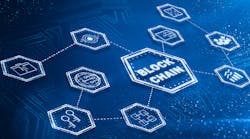Supply chain transparency in the automotive sector is neither clear-cut nor easily attained, thanks to the hundreds of different suppliers involved with taking a vehicle from the raw material stage to the final, drivable product. Even Henry Ford himself—who strove for the ultimate in simplicity when establishing the company’s original manufacturing line—would be amazed by the complexities of the modern-day auto manufacturing supply chain.
Fortunately, technology has come a long way since the first production Model T Ford rolled out of the company’s Detroit plant in 1908. Fast-forward to 2019, and advanced technologies like the Internet of Things (IoT), artificial intelligence (AI), machine learning (ML), and blockchain are beginning to prove themselves as viable supply chain transparency tools.
Blockchain is one advancement that’s already making some waves in procurement circles. In April, Minespider announced that it would start working with Volkswagen to use blockchain to help improve the manufacturer’s lead supply chain. “Minespider and Volkswagen are working together to make procurement both more transparent and secure,” the company said in a press release, adding that blockchain allows participants to trace the supply chain from the point of origin to the factory.
“Sustainability in the supply chain is one of our top priorities,” Volkswagen’s Marco Philippi said in the release. “We see blockchain technology as part of the solution to ensure compliance with environmental and social standards along the entire supply chain.”
Why Blockchain, and Why Now?
An open, distributed ledger that can record transactions between two parties efficiently and in a verifiable and permanent way, blockchain comprises a list of records, or “blocks,” that are linked together using cryptography. By design, a blockchain is resistant to modification of the data, making the technology more reliable than traditional means of sharing data and information across business partners.
In Volkswagen’s case, the goal of the initial blockchain pilot is to work with suppliers and sub-suppliers that account for more than two-thirds of the company’s total lead starter battery requirements. A provider of open-source, public blockchain protocol that was originally designed to identify and address conflict mineral issues, Minespider says Volkswagen’s ultimate aim is to “ensure that all of its raw materials are sourced in a socially and environmentally sound manner.”
Using Minespider’s blockchain technology, for example, Volkswagen will be able to track the origin of its raw materials and present a complete chain of custody from certified mine to end manufacturer. The company uses nested encryption to ensure a company’s data remains private on a public blockchain.
Digital “Certificates” are created at certified mineral sources (i.e., mines or recyclers), which are then encrypted with the company’s public key and posted in a publicly accessible database, Minespider explained in the press release.
“As mineral shipments are sold, responsible data of the new owner is added to the certificate which is re-encrypted with the public key of the new owner, creating a layered encryption like a Russian doll,” the company states. “This ensures that only the owner is able to access the supply chain data, even though it is in a verifiable, immutable public data store, enabling supply chain transparency without sacrificing data security.”
There’s More to Come
Expect more manufacturers to follow Volkswagen’s path by integrating blockchain technology into their supply chain transparency efforts—with a particular focus on mining. For example, Ford Motor Co., has teamed with IBM, China’s Huayou Cobalt, and LG Chem to use blockchain to trace and verify ethically sourced cobalt, one of the minerals used in the lithium-ion batteries that power laptops and electric cars, Bloomberg reports.
“Tantalum, tin, tungsten, and gold, often grouped together in mining industry jargon as 3TG, are vitally important to the industrial economy, used in high-tech products from smartphones to jets,” Stefan Nicola writes in “Using Blockchain to Help Fight Conflict Minerals.” “But these conflict minerals, as they’re known, frequently follow a sketchy path from mine to factory, coming from mines whose profits flow to violent militias, criminals, and even terrorists.”

